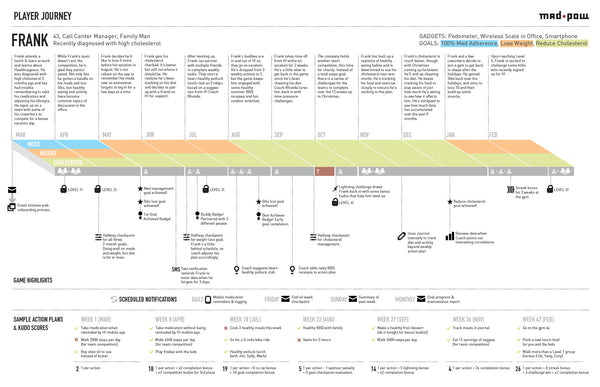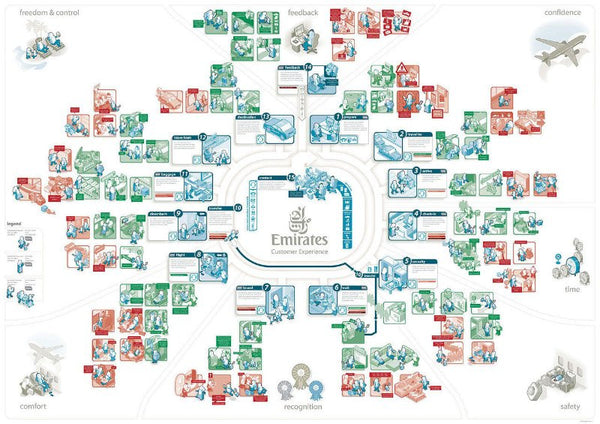Retailers are realizing that as they evolve to meet the expectations of today’s consumers, there’s a growing need for a consistent and superior multi-channel experience.
Customer experience has increasingly become an important factor to success. Almost all (86%) of buyers will pay more for a better customer experience, and 89% of marketers expect customer experience to be a primary differentiator. As a result, more retailers are turning to customer journey mapping to give them the insight they need to make value-driven decisions.
But what does it mean to plan out and analyze the customer journey? What does such a map look like, and how can it be applied tactically to help retail business and bolster sales?
Here, we’ll dive into what a customer journey map is, why you should care as a retailer, and how you can get started on one of your own.
What is a customer journey map?
A customer journey map uses storytelling and visuals to illustrate the relationship a customer has with your business over a period of time — from initial discovery and engagement to advocacy.
The story is being told from the perspective of your customer and is meant to unveil any pain points they’re experiencing to provide you with an actionable plan to address them. In other words, mapping out the customer journey offers retailers the chance to see how your brand first engages a potential customer, then moves through the sales process, and continues into a long-term relationship. And merchants can also assess any customer concerns and address them to reduce any friction — and this is its own opportunity to improve customer service.
 Image Credit: Mad Pow
Image Credit: Mad Pow
Experiencing mapping captures the end-to-end journey and breaks the silos a business often forms when they think of their channels as independent of one another.
It may hone in on one particular piece of the story, or look at the entire picture. In any case, it’s meant to give you an understanding of your customer’s key interactions, their feelings, and motivation, and unearth important questions they need to be answered to move them along in their journey.
Emirates Airlines is a shining example of how leading with and living the customer experience has enabled growth and innovation. Emirates has taken care to map their customer’s journey and ensure all staff members understand what’s expected of them with each interaction, from reservations to in-flight service.
As a result of this, they’ve been able to maintain consistent, superior service, manage rapid growth and increase efficiency. In 2016, the company reported its 28th consecutive year of profit and steady expansion, investing over $20 million into improving the in-flight experience to include internet access, children’s toys, and activity packs.
 Image Credit: Genesys
Image Credit: Genesys
Why create a customer journey map?
A journey map is a powerful tool that enables you to empathize with your customer.
It will give you the context you need to take the guesswork out of decisions by understanding what your customers are trying to achieve, how they arrived at this point, and what they need to move beyond it.
Having this clear picture identifies gaps in your business and specific areas of improvement, and helps you prioritize what should be tackled first. Here are some business goals a journey map can support:
- Breaking down silos between existing departments
- Getting the company working together toward a common goal
- Creating a superior experience that puts the customer front and center
- Providing all employees with a shared vision through which they can make customer-centric decisions
Not to mention, an improved experience can grow revenue by five to 10% over the span of three years.
Convinced yet? Let’s break down how to tackle your first customer journey map.
5 steps to create a customer journey map for retailers
1. Define the goal of the customer journey map
Get consensus on the purpose and scope of the exercise from a variety of stakeholders. Consider whether the aim is to look at the end-to-end journey or a small piece.
Be sure to define:
- what the exercise is meant to accomplish;
- who will use it and how; and,
- how you’ll share what you find with the entire company
2. Know thy customer
Scour your company to establish what’s already known about your customers. Tap on the shoulders of your analytics, search, and social media teams to get an idea of where your customers are coming from, what they’re trying to accomplish and where they’re getting stuck.
Next, talk to your call center representatives, sales staff, and anyone else who has a solid understanding of your customer base. Again, your social media team can provide some insight on what your customers are saying about you online.
Depending on your time and budget, speak directly to your customers to create a true picture (user persona) of your customer. This can be done formally through customer interviews or informally by spending time chatting with them in your retail locations. This is highly recommended if you want to validate the information coming from stakeholders and data.
If you have multiple customer types, focus on your primary one. Create buyer personas, which are a snapshot that will help your company understand their needs, goals, feelings, thoughts and pain points. You can’t understand the journey if you don’t know your customer.
3. Capture all of the ways (and how) they interact with your business
A touchpoint is any moment a potential or existing customer comes in contact with your business — before, during, and after they make a purchase. Two examples of touchpoints are when a customer sees an ad for your business on social media, or they visit your store to investigate your product.
You can get a good idea of touchpoints if you opt for interviewing your primary customers directly. If not, invite the right stakeholders to the table to brainstorm every touchpoint the customer might have and the channels they’re using to make contact. A journey map is a collaborative exercise and it’s important to have mixed representation to consider different perspectives.
4. Talk a walk in your customer's shoes
This step requires you to put yourself in the shoes of your customer to define the major goals they’re trying to achieve in their journey. These goals will represent the stages of your journey and can be high level.
Mull over these questions with your customer hat on:
- What is the customer doing at each stage?
- What do they need to move them to the next stage?
- Why would the customer want to get to the next stage?
- How are they feeling?
- What is stopping them from moving to the next stage?
Take care not to have your journey map reflect your internal business processes. Your business processes can be layered onto your customer’s journey once complete.
5. Visualize the customer journey
This is where you pull together all of the information you’ve gathered so far: customer data and interviews, touchpoints and channels, goals, emotions and motivations. The best place to start is with a paper and pencil or a large whiteboard.
There’s no set template for how you want to represent your customer journey map as long as it clearly communicates your customer’s story. It doesn’t have to be complicated, rather it should easily remind your employees of your customer’s needs.
What’s next for your customer journey map?
A map of your customer’s journey is only the beginning for you. It’s not an easy exercise, but it’s important to share your output with people from all aspects of your business. You should also commit to keeping it updated as your business and customer base evolve.
Lush trains each of its employees on the customer experience. The U.K.-based cosmetics company educates retail associates on the behaviors and expectations of their different customer types and encourages them to recommend products based on a specific need and not a sales target. Associates are also empowered to divert from their regular script if it’s in the best interest of the customer. As a result, Lush has been seen as a leading brand for customer experience in the U.K.
With your map in hand, you’re now better equipped to make more strategic recommendations and decisions.
Read more
- Customer Service Tips: How to Deal With Angry Customers
- Tap Into These Key Customer Triggers to Optimize Your Retail Loyalty Program
- Order History: How Tracking Customer Purchases Can Help You Make More Sales
- What are Repeat Customers and How to Increase Them
- 12 Ways for Retailers to Cope With Customer Complaints
- How to Use Gift Cards to Build Customer Loyalty
- The Apple Store Guide to Insanely Great Customer Service
Customer journey mapping FAQ
What is meant by customer journey mapping?
What are the 7 steps to map the customer journey?
- Define your customer segments: Identify the different types of customers who use your product/service.
- Set goals: Establish the goals you want to accomplish with your customer journey mapping.
- Analyze customer data: Use data from surveys, customer feedback, and other sources to identify customer needs, wants, and trends.
- Map the touchpoints: Create a visual representation of the touchpoints customers use to interact with your product/service.
- Identify pain points: Identify any areas where customers may be experiencing difficulty, confusion, or frustration.
- Find opportunities: Identify potential opportunities to improve the customer experience.
- Develop an action plan: Develop a plan to implement changes based on the results of your customer journey mapping.
What are the 5 stages of customer journey?
- Awareness: This is the stage when customers become aware of a product or service. They might learn about it through advertising, word-of-mouth, or other marketing techniques.
- Consideration: At this stage, customers begin to research and compare different options to determine which product or service best suits their needs.
- Purchase: Customers make their purchase decision and buy the product or service.
- Retention: Customers continue to use the product or service, and may even become repeat customers.
- Advocacy: Customers become advocates, recommending the product or service to others and helping to spread the word.





